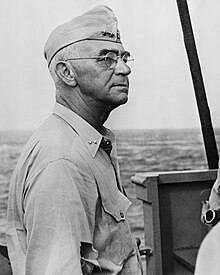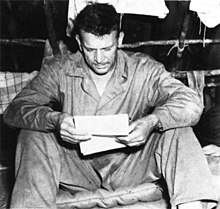New Georgia campaign
The New Georgia campaign was a series of land and naval battles of the Pacific Theater of World War II between Allied forces and the Empire of Japan.The campaign began on 30 June 1943, when US troops carried out landings in the Kula Gulf, in the north of New Georgia, and around the Munda area on the western coast.[1] The Imperial Japanese Army (IJA) believed that holding the Solomon Islands would be ultimately unsuccessful and that it would be better to wait for an Allied attack on Bougainville which would be much less costly to supply and reinforce.[3][4] By early 1943, some Allied leaders had wanted to focus on capturing Rabaul, but Japanese strength there and lack of landing craft meant that such an operation was not practical in 1943.The Allies attempted to neutralize Munda with repeated bombing raids and naval shelling, but the Japanese were always able to repair the airfield in short order.[11] Beginning 21 February, Turner landed the US Army 43rd Infantry Division under Major General John H. Hester and the 3rd Marine Raider Battalion under Lieutenant Colonel Harry B. Liversedge on the Russell Islands, a total of approximately 9,000 troops and their equipment.[12] Alarmed that the Allies were working their way up the Solomons chain, the Japanese bombed the new American base in the Russells and began strengthening their own airfields at Munda and at nearby Vila on Kolombangara.[17] A force consisting of portions of the 4th Marine Raider Battalion and the 103rd Infantry Regiment landed at Oloana Bay on the south coast of Vangunu Island on 30 June.[18] Meanwhile, the remainder of the 4th Marine Raider Battalion captured Viru Harbor, supported by dive bombers, on 30 June, after advancing overland from Lambeti Plantation.[25][26] The crossing was undertaken in daylight by elements from two regiments in the afternoon of 2 July; a small perimeter was established around Zanana and defenses built up before the advance westwards towards Munda Point began several days later.They loaded 4,000 troops on destroyers, brought them down "The Slot" on the night of 4–5 July via the "Tokyo Express," and landed them at Vila on the southeast coast of Kolombangara.[28] From there, the men would be ferried across Kula Gulf on barges to Bairoko on the northwest coast of New Georgia, before moving along eight-mile jungle trail to Munda.Halsey had dispatched transports carrying 4,600 troops consisting of Marine Raiders and two US Army battalions under Colonel Liversedge to Rice Anchorage on the northwest coast of New Georgia.At the same time, a long-anticipated change in naval command took place with Rear Admiral Theodore Stark Wilkinson taking over leadership of the amphibious forces from Turner on 15 July.[41] US forces, bolstered by the arrival of the 37th Infantry Division, subsequently launched a corps-level offensive under Griswold aimed at capturing Munda Point.But the Japanese defensive positions were well designed and had been reinforced since the initial US landing at the Rice Anchorage;[45] as a result, neither force made any progress, and US casualties began to mount.Under the protection of a single destroyer, 940 troops and 700 naval personnel were loaded aboard three destroyer-transports and sent down under the command of Rear Admiral Kaju Sugiura to Kolombangara on the night of 6–7 August.[50] Following this major reversal, Sasaki moved his headquarters to Kolombangara on 8–9 August, leaving behind a token force to defend the west coast of New Georgia.His mission now was simply to hold the remaining islands of the New Georgia group as long as possible, giving the Japanese a chance to reinforce the northern Solomons.[54] A large invasion force of about 6,500 troops led by Major General Robert B. McClure, escorted by 12 destroyers under the command of Wilkinson was dispatched from Guadalcanal early on 14 August.Horaniu, on the northeast coast, was selected as a barge staging point and on the night of 17–18 August a small force of ground and naval troops was sent to secure the area.[57] On the night of 6–7 October, Rear Admiral Ijuin Matsuji led a naval force to take the 600 remaining ground troops off Vella Lavella.[63] Elsewhere, in New Guinea, commencing in late September, the Allies launched campaigns in the Markham Valley and on the Huon Peninsula as part of efforts to secure Lae and Finschhafen.Morison further criticizes the failed flanking move undertaken by Hester's troops to break the deadlock during the initial drive on Munda, describing it as "perhaps the worst blunder in the [campaign]".









Solomon Islands campaignWorld War II25th Infantry DivisionNew Georgia IslandsSolomon IslandsUnited StatesNew ZealandAustraliaDouglas MacArthurWilliam F. HalseyRichmond K. TurnerTheodore S. WilkinsonFrederick MoosbruggerAaron S. MerrillWalden L. AinsworthThomas J. RyanJohn F. KennedyHarry B. LiversedgeOscar W. GriswoldMillard F. HarmonJohn H. HesterRobert B. McClureH. E. BarrowcloughJinichi KusakaTeruo AkiyamaShunji IsakiKaju SugiuraMatsuji IjuinHitoshi ImamuraMinoru SasakiRussell IslandsViru HarborRendovaWickhamMunda driveEnogaiCounterattackBairokoMunda Point Vella Lavella (land)Arundel IslandBlackett StraitKula GulfKolombangaraVella GulfHoraniuVella Lavella (naval) Solomon Islands campaign TulagiGuadalcanalVengeanceSO and SETreasury IslandsChoiseulBougainvilleGreen IslandsNeutralisation of RabaulSouth West Pacific theatre of World War IIPhilippines campaign (1941–1942)Lamon Bay1st Bataan1st CorregidorDutch East Indies campaign1st Borneo1st Tarakan1st BalikpapanManadoSumatraBadung StraitJava Sea2nd Borneo2nd TarakanNorth Borneo2nd BalikpapanNew Guinea campaignCoral SeaKokoda TrackBuna–GonaBismarck SeaNassau Bay LandingSalamaua-LaeHuon PeninsulaAdmiralty IslandsAitape-WewakRecklessPersecutionNoemfoorMorotaiNew Britain campaignOperation CartwheelCape GloucesterTalaseaJacquinot BayWide Bay–Open BayPhilippines campaign (1944–1945)Leyte GulfLingayen Gulf2nd CorregidorVisayasMindanaoBorneo campaignTarakanLabuanBeaufortBalikpapanPacific TheaterAlliedEmpire of JapanRabaulNew GeorgiaWickham Anchorageadvance on Mundastrong counterattackcaptured Munda Pointlanded on Vella LavellaVella LavellaJapaneseGuadalcanal offensivesNew BritainImperial Japanese ArmyImperial Japanese NavySanta IsabelMinoru (Noboru) SasakiJoint Chiefs of StaffSouth West Pacific Area'sNew Guinea